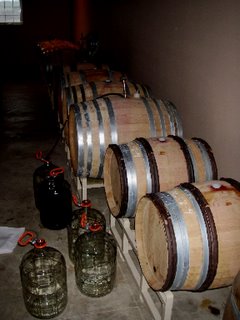Vineyard Management
It’s time to shift gears; I have a vineyard to tend.
Some friends own Sunny Ridge Vineyard, and they invited me to tend it for them. I’m a hands-on person, and a reasonably accomplished plant grower. Plus, I’ve taken the viticulture class through Chemeketa Community College. With my background and a little coaching from Randy Coleman, I think I can learn a tremendous amount about growing grapes, and perhaps even produce some good fruit from this vineyard.
Sunny Ridge Vineyard is a small vineyard located near my winery. It’s an established site, but recently it’s seen tremendous change. It was originally planted to Pinot gris, and it produced good fruit. However, last year, the vines were grafted over to Pinot noir (Pommard clone).
This entails cutting off the vine completely at the top of the trunk. This retains the established rootstock and trunk, and provides an excellent grafting point. Last winter, two canes were grafted onto each trunk. A walk through the vineyard late last summer revealed that roughly 80% of these grafts took.
Amazingly, these newly grafted vines should produce a usable crop the second year (2006).
It’s time to shift gears; I have a vineyard to tend.
Some friends own Sunny Ridge Vineyard, and they invited me to tend it for them. I’m a hands-on person, and a reasonably accomplished plant grower. Plus, I’ve taken the viticulture class through Chemeketa Community College. With my background and a little coaching from Randy Coleman, I think I can learn a tremendous amount about growing grapes, and perhaps even produce some good fruit from this vineyard.
Sunny Ridge Vineyard is a small vineyard located near my winery. It’s an established site, but recently it’s seen tremendous change. It was originally planted to Pinot gris, and it produced good fruit. However, last year, the vines were grafted over to Pinot noir (Pommard clone).
This entails cutting off the vine completely at the top of the trunk. This retains the established rootstock and trunk, and provides an excellent grafting point. Last winter, two canes were grafted onto each trunk. A walk through the vineyard late last summer revealed that roughly 80% of these grafts took.
Amazingly, these newly grafted vines should produce a usable crop the second year (2006).


